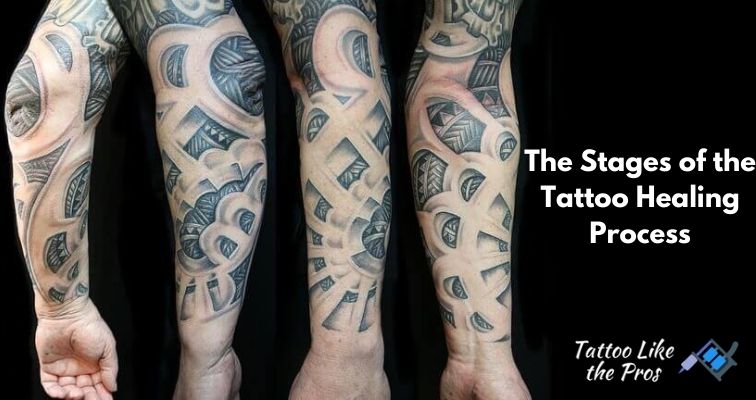The tattoo healing process is something anyone seldom thinks about before they get ink.
But, once puss makes its debut, people usually go running to see if it’s normal.
The following information may help answer your questions so that you feel comfortable with the process of getting a tattoo.
Why do Tattoos Need to Heal?
The tattoo process uses a fine needle to inject tiny dots of ink into your skin. This makes holes in the skin, essentially creating a wound that the body must heal to remain healthy. The healing process will continue until the body is restored to its pre-tattoo state, except the ink that lies underneath the skin.
Stage One of the Tattoo Healing Process
The first stage of healing for a tattoo will encompass about a week, depending on the individual. Everyone heals at a different rate, colored inks take longer to heal, and so forth, so the healing time for the first stage will vary somewhat.
During this period, the skin will redden and swell, and there will be some oozing of fluid over the tattooed area(s). The first couple of days is the worst and the most painful. Your immune system will be working overtime to reduce the inflammation and start the clotting process that is the precursor to the actual healing process.
The tattoo artist should have cleaned the area with an antibacterial agent, and then bandaged the area. Although it’s tempting to want to show off the new tattoo, it’s important to leave it bandaged so that bacteria doesn’t enter your skin and cause an infection. You should leave the bandage(s) on for a minimum of 12 hours and some recommend 24 hours.
Removing the Bandage
When the dressing is removed, the area may ooze blood and ink. This is your immune system working to rid the area of what it considers an invader and repair itself. When you are comfortable, but either the same day or the next day, gently wash the area with a hypoallergenic soap and warm water.
Don’t scrub or use a cloth; use your fingers only in a circular motion. It’s important to keep your new tattoo clean so that it doesn’t dry out, which can cause the formation of large scars.
Your new tattoo will be very sore for the next few days, and you’ll probably feel like you have a substantial sunburn. It will likely be inflamed and perhaps bruised. This is normal. The inflammation is the body’s way of fighting bacteria and healing itself. The inflammation shouldn’t last for more than a week. If it does, seek the advice of a medical professional.
Your new tattoo will probably be raised also. Again, this is part of the healing process and is nothing to be alarmed about unless it lasts for more than a few days. If you had a good tattoo artist, there should be minimal bruising, but the soreness can last for a while. Some cloudiness may appear, and this is normal; the color should return when it is healed.
Second Stage of Tattoo Healing
At this point, you’ll begin to experience what is arguably the worst stage of the process, which is the flaking and itching. The scabs will have hardened, and some of the smaller ones have probably fallen off. This stage will last for about a week.
The skin becomes very dry and itchy unless you keep it well moisturized. It’s imperative to avoid the temptation to scratch because that can ruin the lifelong appearance of your tattoo. It’s common to moisturize a tattoo six or seven times each day, or whatever your skin needs to stay supple and well hydrated.
When moisturizing, make sure to apply only what you need. The tattoo needs to breathe, so you don’t want a thick coating of lotion on it. Be sure to moisturize dry skin only; if the skin is wet and you apply lotion on top of the tattoo, the scabs can loosen prematurely and damage the tattoo.
Your skin can have excessive peeling for a few days and look very unsightly. Don’t worry. This is a normal part of the healing process. The old, damaged skin is being replaced with new skin that will cover your tattoo. Peeling shouldn’t last for more than three or four days.
Third Stage of Tattoo Healing
You’re almost done with the tattoo healing but may be concerned about the cloudy appearance of your new artwork. You may have a few lingering scabs but resist the urge to remove them.
Your tattoo is probably still dry and may appear cloudy and dull. It’s important to keep still it moisturized at this point. In the sunlight, even a dull tattoo may look glossy; this is normal. Your skin will continue to rejuvenate over the next one or two months, but then your tattoo should have the appearance you wanted.
If any spots need a touch-up, you can schedule that with your artist at this point; the skin will have sufficiently healed to allow a touch-up.
The Final Stage of Healing
It will take between four and six months of your skin and tissues to heal completely; the time frame will vary by the individual. The success of this final stage will depend entirely on how well you have taken care of your new ink in stages one through three.
At this point, you can start exposing your new ink to the sunlight again but be cautious not to get it sunburned. You can also start swimming again. Up to this point, exposure to the chlorine in swimming pools can cause your new ink to bleach out, and it will dry your skin.
